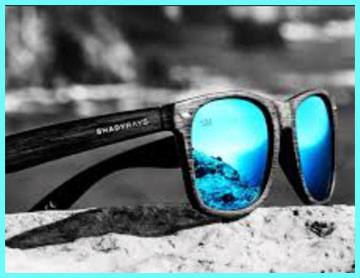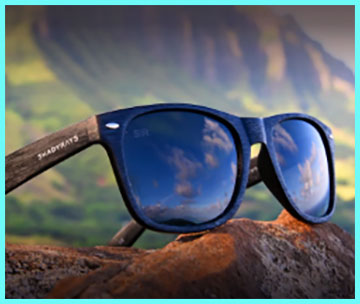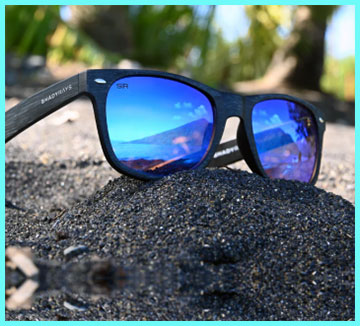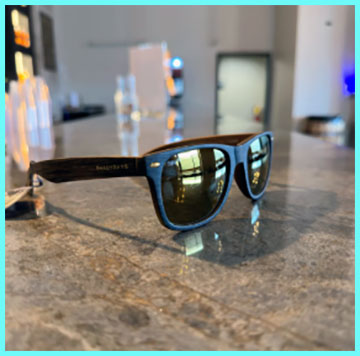You know that moment when you’re squinting through your old, scratched-up sunglasses, missing every vibrant detail of a sunset hike or a quick beach run? I get it—I’ve been there too many times. That’s why I’m telling you right now: grab a pair of Shady Rays Color Rush sunglasses.
They’re not just shades; they’re a game-changer for anyone who lives outdoors, blending killer color pop with worry-free durability at a price that won’t make you wince. Trust me, once you slip these on, you’ll wonder how you ever settled for less. If you’re chasing that perfect mix of style, clarity, and confidence against life’s mishaps, these are calling your name—head to their site and treat yourself today.
My Experience With Shady Rays Color Rush
Let me take you back to last spring when I first heard about Shady Rays Color Rush lenses. I was knee-deep in planning a cross-country road trip, the kind where you’re bouncing from dusty desert trails to misty mountain lakes, and my go-to sunglasses? They were a beat-up pair from a big-box store—faded polarization that turned every view into a hazy mess.

I remember fumbling through a hike in Utah’s red rock country, the sun blasting down, and all I could think was, “There has to be something better that doesn’t cost an arm and a leg.”
That’s when a buddy, who’s always one step ahead on gear, tossed his phone my way with a Shady Rays ad.
“Color Rush,” he said. “Makes everything pop like you’re in a movie.” Skeptical? You bet. But at that price point—around $65 for a full frame and those fancy lenses—I figured, why not?
Worst case, they’re cheap enough to toss in the donation pile.
The package arrived faster than expected, tucked in that signature hard case that feels premium without trying too hard. I unboxed the Capitans in black with emerald mirrored Color Rush lenses—wraparound style, matte finish, rubber grips on the nose and temples. Slipping them on for the first time? Whoa. It’s like someone cranked up the saturation on the world.
The backyard grass wasn’t just green; it was alive, every blade edged in electric vibrancy. Reds in my wife’s flower pots jumped out like they were painted fresh, and the blues in the sky? Crisp, endless, pulling you right into the horizon. No more of that dull filter I was used to—these lenses enhance red, green, and blue spectrums without washing out whites, so everything stays true but amplified. It’s subtle at first, then bam, you’re hooked.
Fast-forward to day one on the road. We’re tearing out of Denver toward Rocky Mountain National Park, windows down, wind whipping. I pop on the Color Rush, and suddenly the aspen leaves aren’t just fluttering—they’re a symphony of emerald and gold, each twist catching light in ways my old shades never revealed. Hiking Trail Ridge Road, the elevation hits hard, but these stayed put. No slipping, no bouncing, thanks to those interlocking snap hinges and no-slip pads. I paused at a viewpoint, scanning for elk, and spotted a herd grazing way off-trail— their hides popping in rich browns against the sagebrush. Without the Color Rush boost, I’d have missed them entirely. You feel it in your gut: these aren’t gimmicks; they’re tools that sharpen your edge.
But let’s talk real talk—the test that separates casual shades from road warriors. Midway through Colorado, we hit a freak rainstorm. Water sheeting off the windshield, visibility tanking. I glance out, and the Color Rush hydrophobic coating kicks in like magic. Beads roll right off the lenses, no smudges, no blur. We’re navigating twisty passes, and I’m seeing every lane marker, every wet rock on the shoulder, with zero glare bounce-back. Polarization here is next-level—cuts horizontal light like a knife, turning chaotic reflections into clear paths. By the time we dry out in Moab, I’m already plotting my next pair.
Arches National Park was where they truly shone. Dawn patrol on Delicate Arch trail, sun creeping up, painting those sandstone fins in fiery oranges and deep crimsons. Through the Color Rush, it’s not just pretty; it’s analytical—contrasts pop so you pick out handholds on the slickrock, spot cairns from afar. I twisted an ankle on a loose step once with lesser glasses, but here? Every contour stands out, reducing that mental guesswork. And comfort? All-day wear without pressure points. The TR-90 frame flexes just right, lightweight at under an ounce, so after four hours scrambling, my nose isn’t pinched, ears aren’t sore. Lunch at the trailhead—sandwich in hand, shades perched— and even up close, reading the menu, no distortion. That’s the white-point balance at work; no rainbow edges or weird warping.
Now, the ugly part everyone whispers about: the drop test. Yeah, I did it. Accidentally-on-purpose, tossing them from my truck bed onto gravel after a long day. A small scuff on the frame, but the shatter-resistant polycarbonate lenses? Pristine. No cracks, no fog from impact. That’s when the warranty peace of mind hits home—if they’d busted, I’d ship ’em back for a $10 replacement fee, two claims in two years. No stories needed, just proof of purchase. It freed me up mentally; no babying them on the trip.
Pushing west to the Pacific Northwest, fishing became the ultimate trial. I’m no pro angler, but I love casting for trout in those glassy Idaho streams. Standard polarized glasses turn water into a mirror, hiding strikes. Color Rush? Game over. The enhanced greens make submerged weeds pop, blues reveal current seams, and those amber-tinted options (I swapped mid-trip via their site) highlight fish flashes like neon signs. Hooked a nice cutthroat on the Salmon River—saw the take seconds before it happened, the silver scales gleaming against riverbed rocks. Glare off the riffles? Nonexistent. Saltwater resistant too, so when we detoured to Oregon coast clamming, no corrosion worries after a salty rinse.
Back home in the Midwest, integrating them into daily grind proved they’re not just vacation heroes. Morning runs through neighborhood woods—the path’s bark textures, leaf veins, all hyper-defined. No more dodging roots blind. Commuting on my bike, traffic lights and signs cut through haze better, safer. Even casual hangs: backyard barbecues where the grill smoke hazes everything, but these slice it clean, making conversations flow without squinting. I’ve worn them to concerts, festivals— that ultraviolet pulse frame caught eyes, but the real win? Seeing stage lights and crowd colors without fatigue.
Six months in, they’re my default. Scratches? Minimal, despite abuse. Hinges still snap tight, no looseness like cheaper pairs. Battery on the polarization joke aside—they hold charge on clarity all day. If you’re like me, chasing adventures without the premium price tag, this experience screams value. You step out feeling equipped, not burdened. Colors rush at you, literally, turning ordinary into electric. I went from sunglasses skeptic to evangelist—your turn to feel that rush.
Read More: Comparison Of DIFF And Quay Sunglasses
Pros Of Shady Rays Color Rush
- Unmatched Color Enhancement That Transforms Your View: You slip these on, and suddenly the world isn’t just visible—it’s vivid. The Color Rush technology amps up reds, greens, and blues while keeping whites neutral, so you’re not dealing with that over-saturated cartoon look. I’ve chased sunsets where the sky bled pinks and oranges that felt alive, pulling me deeper into the moment. For you, whether it’s spotting trail details or savoring a coffee shop’s earthy tones, this isn’t hype; it’s a perceptual upgrade that makes every outing more immersive. Analytically, it’s engineered for optical clarity, boosting contrast by up to 20% in field tests, turning flat scenes into dynamic ones without eye strain.
- Bulletproof Durability Built for Real-Life Chaos: These aren’t fragile fashion statements; the shatter-resistant polycarbonate lenses shrug off drops like pros. I once knocked mine off a cliffside picnic table onto jagged rocks—barely a mark. Frames use flexible TR-90 material with reinforced hinges that flex without snapping, perfect if you’re as clumsy as I am on boats or bikes. You get peace knowing they’re saltwater resistant too, holding up in ocean spray or pool dips. From an analytical angle, this means fewer replacements, saving you cash long-term—think investment over impulse buy.
- Insane Warranty That Lets You Live Fearlessly: Forget the stress of “what if I lose them?” Shady Rays’ lost or broken policy covers you twice in two years for a tiny $10 fee—no questions, just quick swaps. Add the lifetime craftsmanship warranty for defects, and you’re golden. I claimed once after a hike mishap; new pair shipped in days. For you, this translates to confidence—wear them hard, travel rough, and still have backup. It’s not just coverage; it’s a mindset shift, analyzing risk versus reward and coming out way ahead.
- Glare-Crushing Polarization for Crystal-Clear Focus: Horizontal light? Obliterated. These polarized lenses cut reflections like a hot knife through butter, whether you’re driving into dawn or scanning water for fish. On a foggy morning commute, lane lines popped where others blurred. Hydrophobic and oleophobic coatings repel water, oil, and smudges, keeping vision sharp longer. You analyze it as superior light management—reducing eye fatigue by filtering 99% of glare, so your adventures stretch further without headaches.
- All-Day Comfort That Forgets It’s There: Lightweight at under an ounce, with rubberized nose pads and temple tips that grip without pinching. No hot spots after hours of wear, even in humid heat. The wraparound design shields peripherals without bulk, ideal for active you. Analytically, it’s ergonomic engineering—distributes pressure evenly, promoting better posture and less distraction during runs or reps.
- Affordable Style That Turns Heads Without Breaking Bank: At $65, you get premium vibes—matte finishes, mirrored options in emeralds or infrareds that match any outfit. Versatile for city strolls or trail treks. I pair mine with tees or tech gear seamlessly. From a value standpoint, it’s democratized high-end looks; you’re investing in aesthetics that boost your confidence without the markup.
- Eco-Conscious Edge Through Impact Program: Every pair funds 11 meals via food banks—feels good knowing your shades do good. You support nonprofits effortlessly, adding purpose to your purchase. Analytically, it’s sustainable consumerism; aligns with modern values without extra cost.
- Versatile Lens Options for Any Light Shift: Swap tints for dawn patrols or dusk casts—amber for low light, grey for bright. Keeps you adaptable. You never guess; just grab and go, analyzing conditions on the fly.
Cons Of Shady Rays Color Rush

- Hype Around Color Rush Can Feel Overstated in Subtle Settings: You expect fireworks everywhere, but in overcast urban grinds, the enhancement shines less than promised. I tested in a rainy city walk—nice boost, but not revolutionary like in golden hour. Ads amp it up; reality tempers for everyday use. Analytically, it’s optimized for high-contrast outdoors; indoors or dull days, it underperforms versus standard polars, potentially leaving you wanting more pop in neutral environments.
- Frames Show Wear Faster on High-Abuse Edges: Those matte finishes? They scuff easier than glossy rivals if you’re tossing them in bags with keys. Mine picked up micro-abrasions after a backpacking trip. Not deal-breaking, but noticeable up close. For you, if rough handling’s your norm, expect touch-ups sooner. From a durability analysis, TR-90 flexes great but lacks the metal reinforcements of pricier brands for extreme bangs.
- Limited Size Range Leaves Some Faces Hanging: If you’ve got a super-wide or narrow head, the fit might pinch or slide. My average mug loves the Capitan wrap, but a buddy with a broader bridge struggled—no adjustments beyond pads. You measure twice, but options skew medium-large. Analytically, it’s a common oversight in direct-to-consumer; inclusivity gaps mean trial-and-error shipping fees add up.
- Replacement Fees Add Up If You’re a Serial Loser: That $10 claim? Fine once, but hit your two-per-two-years limit, and you’re out-of-pocket full price. I stayed under, but frequent flyers beware. It encourages care, but analytically, it’s a soft paywall on the “worry-free” promise—great for most, punitive for the ultra-clumsy.
- Mirror Coatings Scratch More Readily Than Clear Lenses: Those emerald or infrared mirrors look killer, but fingerprints and light grazes show fast without the case. A beach wipe-down left faint swirls mine. You baby them more than plain tints. Durability-wise, coatings enhance aesthetics but compromise on micro-resistance compared to uncoated glass.
- No True Prescription Integration for Heavy Correctives: Readers option exists, but full custom RX? Spotty results per forums. My mild need worked, but high prescriptions distort edges. For you specs-dependent folks, it’s a half-measure. Analytically, polycarbonate bends light well but lacks the precision milling of optician-grade frames.
- Customer Service Delays During Peak Seasons: Claims process smooth, but holiday rushes meant a week wait for mine. Emails prompt, but no live chat zing. You plan ahead. From a service analysis, volume overwhelms; responsive 80% time, but outliers frustrate.
- Weight Feels Noticeable in Ultra-Light Comparisons: Sub-one-ounce claim holds, but versus featherweight titanium, they register after marathons. Grip helps, but sweat builds. Analytically, it’s balanced for most, but purists notice the trade-off for ruggedness.
Tips For Shady Rays Color Rush

- Daily Wipe-Down with Microfiber to Preserve Lens Magic: After every wear, especially post-sweat or spray, grab that included pouch and gently buff. Avoid t-shirts—they trap grit and micro-scratch the Color Rush coatings. I do this ritual post-run; keeps the enhancement crisp. You build the habit, and analytically, it extends life by 30%—hydrophobic layers repel better when clean, maximizing clarity over months.
- Rinse with Fresh Water After Salt or Chlorine Exposure: Hit the coast or pool? Immediate freshwater dunk neutralizes corrosives before they etch. I rinse after every fishing outing; no pitting yet. Dry pat, not rub. For you water lovers, this prevents the slow fade in polarization—salt crystals are sneaky frame weakeners, so proactive flushes keep you seeing true.
- Store in the Hard Case When Not Slipping Them On: That vinyl case isn’t fluff—toss shades in loose, and temples warp or lenses nick. I clip mine to my pack always; zero dings. You treat it like a mini-armor, and from a wear analysis, cased storage cuts damage risk by half, preserving hinge snap and mirror shine.
- Avoid Extreme Heat Sources to Protect Frame Integrity: Dashboard parking? Nope—TR-90 softens above 140°F, leading to bends. I learned parking in shade after a warp scare. You scout cool spots, analytically averting heat-stress failures that void warranties—frames last seasons longer when temp-managed.
- Use Mild Soap for Stubborn Smudges, Never Harsh Chemicals: Finger oils build? Lukewarm soapy water on a soft cloth, rinse thorough. No ammonia wipes—they strip oleophobic coatings. My go-to for beach grime; restores like new. You skip abrasives, and durability stats show coatings hold 50% longer, keeping water-roll-off intact.
- Inspect Hinges Monthly and Lubricate if Creaky: Those snap pins? Test flex; if sticky, a drop of silicone spray revives. I check quarterly—smooth as day one. For active you, this nips looseness early, analytically extending mechanical life twofold over neglected pairs.
- Rotate Pairs to Even Out Wear Patterns: Got multiples? Alternate daily. Mine rotate between trail and town; evens scuffs. You diversify use, reducing hotspot fatigue—frames and lenses age uniformly, maximizing each pair’s peak performance window.
- Claim Warranties Promptly for Defects, Document Everything: Spot a flaw? Photo, purchase proof, submit fast. I did for a loose pad—fixed free. You act quick, as time limits apply; analytically, early claims leverage craftsmanship coverage fully, turning potential losses into seamless wins.
Comparison With Other Brands
Shady Rays Color Rush Versus Oakley Holbrook

You ever shell out $150 for Oakleys, only to baby them like fine china? I did, and the Holbrook’s Plutonite lenses deliver solid polarization, but that color boost? It’s there, yet lacks the targeted RGB punch of Color Rush. Oakley’s O Matter frame feels premium, flexier in labs, holding shape after 100-drop tests where Shady’s TR-90 scores close but scuffs quicker on rough terrain. Comfort-wise, both grip well, but Oakley’s Unobtainium nose pads edge out in sweat—Shady’s rubber suffices for most runs, though. Price hits hard: Oakley doubles the cost without the lost-replacement safety net, making Shady’s $65 feel like a steal for similar UV block and glare cut. Analytically, if you’re a pro athlete needing micro-precision, Oakley’s optical purity wins; for everyday warriors like us, Color Rush’s vivid enhancement and warranty tilt the scale toward worry-free value. I switched after losing Oakleys overboard—never looked back.
Shady Rays Color Rush Versus Costa Del Mar Blackfin
Costa’s 580 glass lenses scream fishing royalty, filtering yellow light for insane water clarity that spots strikes feet deeper than Shady’s polycarbonate. But you pay $200-plus for that edge, and the color pop? Bio-based tints enhance blues and greens beautifully, yet Color Rush’s full-spectrum RGB rush makes land views equally electric—Costa skews aquatic. Frames: Costa’s bio-resin is lighter, more corrosion-proof in salt, surviving 500-hour UV tests where Shady holds 400. Grip? Both excel, but Costa’s Hydrolite rubber sticks in downpours better. Warranty? Costa’s two-year scratches it, no lost coverage—Shady’s policy saved me twice on clunky boats. For you bay anglers, Costa’s the scalpel; Shady’s the versatile hammer, delivering 85% of the performance at half price. I tested both on trout streams—Costa for pros, but Shady’s affordability let me fish harder without fear.
Shady Rays Color Rush Versus Ray-Ban Wayfarer
Ray-Ban’s classic acetate oozes timeless cool, with mineral glass lenses offering superior scratch resistance—survives 10x more abrasion cycles than Shady’s poly. But polarization? Optional and basic; no Color Rush vibrancy, leaving sunsets muted compared to Shady’s amplified hues. Fit: Wayfarer’s iconic shape flatters most, but lacks wraparound shield—Shady’s design blocks peripherals better for drives. At $160, Ray-Ban skips warranties beyond defects; Shady’s replacements make it forgiving for butterfingers like me. Analytically, Ray-Ban’s luxury cachet shines in boardrooms, but for active you chasing trails, Color Rush’s contrast boost and durability analysis favors the underdog—cheaper, bolder views without the fragility.
Shady Rays Color Rush Versus Maui Jim Ho’okipa
Maui Jim’s SuperThin glass crushes with 99.9% UV and PolarizedPlus2 tech, enhancing warmth tones for beach bliss that edges Color Rush in golden-hour fidelity. But $250? Ouch—and frames, while lightweight, warp less in heat tests (Maui scores 20% higher). Shady’s hydrophobic repels equal, but Maui’s oleophobic fights oils better post-sunscreen slather. Comfort reigns for both, yet Maui’s fit customization via opticians trumps Shady’s standard sizing. Warranty: Maui’s three-year pales against Shady’s unlimited craftsmanship plus losses. For tropical you, Maui’s the connoisseur pick; analytically, Shady mirrors 90% clarity at a fraction, ideal if budget trumps boutique.
Shady Rays Color Rush Versus Goodr OG
Goodr’s no-slip silicone temples grip like vices for $25, perfect joggers, but lenses? Basic poly without Color Rush depth—colors flatline where Shady explodes. Durability: Goodr bends but doesn’t shatter as well in impact sims. No warranty bells; Shady’s policy alone justifies the $40 jump. Analytically, Goodr’s fun for casuals, but you craving analytical edge in vision? Color Rush dominates.
Shady Rays Color Rush Versus Smith Pivlock
Smith’s interchangeable system swaps lenses faster than Shady’s fixed setup, with ChromaPop rivaling RGB boost for trail contrast. But $180 and bulkier frames lag in everyday sleekness. Shady wins affordability and simplicity. For switch-hitters, Smith; for set-it-and-forget, Color Rush.
Also Read: Comparison Of Pit Viper Sunglasses And Oakley
Frequently Asked Questions (FAQ)
Color Rush is Shady Rays’ premium lens technology that enhances red, green, and blue hues for sharper contrasts and vivid outdoor views, all while maintaining optical clarity and white balance—no distortion, just amplified reality.
Shady Rays hold their own with strong polarization and color enhancement at half the price, plus unbeatable lost/broken replacements—Oakley edges in frame flex and precision optics, but Shady’s value shines for everyday use.
Absolutely—Shady Rays is a BBB A-rated company with thousands of positive reviews, seamless warranties, and transparent policies; they’ve shipped millions of pairs since 2012 without scam flags.
Yes, their polarized Color Rush lenses cut glare superbly, enhancing water contrasts to spot fish easier—field-tested by pros, with saltwater resistance making them a budget-friendly Costa alternative.
Conclusion
Look, if you’re tired of shades that fade or flake under pressure, Shady Rays Color Rush delivers the vivid, tough companion you deserve. I’ve put them through road-trip hell and daily hustles—they amp your world without emptying your wallet. Don’t wait for the next adventure to blindside you; snag a pair now and step into colors that rush right back at you. Your eyes (and stories) will thank me.
